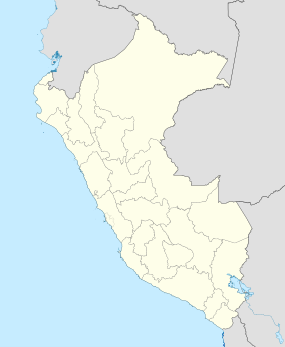Chan Chan
From top: Chan chan view, capital of Chimor, Chan Chan walls, Adobe detail at Chan Chan, Panel of warriors detail of wall , Pelican in chan chan, Chan Chan Model, a wall in Chan Chan
|
||||||||||||
| Location | La Libertad Region, Peru | |||||||||||
|---|---|---|---|---|---|---|---|---|---|---|---|---|
| Coordinates | 8°6′21″S 79°4′28″W / 8.10583°S 79.07444°WCoordinates: 8°6′21″S 79°4′28″W / 8.10583°S 79.07444°W | |||||||||||
| History | ||||||||||||
| Founded | 850 | |||||||||||
| Cultures | Chimú culture | |||||||||||
| Official name | Chan Chan Archaeological Zone | |||||||||||
| Type | Cultural | |||||||||||
| Criteria | i, iii | |||||||||||
| Designated | 1986 (10th session) | |||||||||||
| Reference no. | 366 | |||||||||||
| Region | Latin America and the Caribbean | |||||||||||
| Endangered | 1986–present | |||||||||||
Chan Chan, the largest city of the pre-Columbian era in South America, is now an archaeological site in La Libertad Region 5 kilometres (3.1 mi) west of Trujillo, Peru.
Chan Chan is located in the mouth of the Moche Valley and was the capital of the historical empire of the Chimor from 900 to 1470, when they were defeated and incorporated into the Inca Empire. Chimor, a conquest state, developed from the Chimú culture which established itself along the Peruvian coast around 1400 AD. In the Chimú tongue, Quingnam, Chan Chan means "Sun Sun;" it was named for its sunny climate which is cooled year round by a southerly breeze.
Chan Chan is in a particularly arid section of the coastal desert of northern Peru. Due to the lack of rain in this area, the major source of water for Chan Chan is in the form of rivers carrying surface runoff from the Andes. This runoff allows for control of land and water through irrigation systems.
The city of Chan Chan spanned 20 km² and had a dense urban center of 6 km² which contained extravagant ciudadelas.Ciudadelas were large architectural masterpieces which housed plazas, storerooms, and burial platforms for the royals. The splendor of these ciudadelas suggests their association with the royal class. Housing for the lower classes of Chan Chan's hierarchical society are known as small, irregular agglutinated rooms (SIARs). Because the lower classes were often artisans whose role in the empire was to produce crafts, many of these SIARs were used as workshops.
The coordinates chosen at right for the location of Chan Chan were determined using "Figure 1: Archaeological Zone of Chan Chan" from Michael West's article, "Community Settlement Patterns at Chan Chan, Peru". In this figure, it can be seen that Verlarde, Laberinto, and Bandelier form the northern border of Chan Chan while Uhle, Chaiguac, Tschudi, and Rivero form its southern flanks. The location chosen for the coordinates is in the center of these cities and so represents a central location for the ruins of Chan Chan amidst this archaeological zone.
...
Wikipedia










